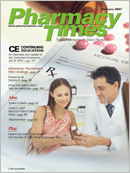Publication
Article
Pharmacy Times
Compounding Dental Applications
Author(s):
Whereas compounding is arewarding departure fromthe pharmacy norm, compoundingfor dental patients and practicescan be particularly rewarding, aswell as lucrative. Conditions includingchronic mucositis, infectious processes,and oral pain syndromes may callfor specialized treatments and deliverymethods not available on the commercialmarket.1 In addition, some dentalpractices order and maintain certainpreparations in stock, as well as prescribingfor individual patients preparationsthat are to be dispensed at thepharmacy.
Oral ulcerations can be caused by anumber of disease states and may berecurrent. Disorders include lichenplanus, oral pemphigus, Behcet's disease,and aphthous ulcers (cankersores).2 Oral ulcerations also may bedrug-induced and are more common inpatients with compromised immunesystems. These oral conditions arequite painful and may interfere withthe patient's ability to eat, drink, orspeak.
Topical applications can be preparedto reduce pain and inflammation and,in some cases, may help prevent orcure the problem. Compounds fortreating oral mucositis frequentlyinclude the following:
- Analgesics (lidocaine, tetracaine)
- Antibiotics (tetracycline, erythromycin)
- Antifungals (nystatin, clotrimazole)
- Antihistamines (diphenhydramine,chlorpheniramine)
- Steroids (triamcinolone, hydrocortisone)
Mouthwashes and rinses are the mostcommon dosage forms for dentalpatients, although compounding allowsfor such options as pastes, troches, orhard candies and, in some situations, lollipops.It is, however, important to choosea vehicle with little or no alcohol whenpreparing compounds for oral mucositis,because alcohol tends to cause drynessand irritation, which can exacerbate oralulcerations. Compounding pharmacistsalso have the benefit of being able to flavorcustom medications according to thepatient's individual preferences?whichtypically increases compliance.
A particularly useful preparation foraphthous ulcers is one that was oncecommercially available but was removedfrom the market by its manufacturer.Polyphenol sulfonic acid complex,which was marketed under thename Negatan, is applied directly tothe site. Although it burns whenapplied, the sore is essentially instantlycauterized, and in most cases no furthersymptoms are reported. In somesituations, however, an additionalapplication is needed.3
Another highly effective compoundedtreatment for oral lesions is a preparationof misoprostol in a mucoadhesiveanesthetic powder.4 This dry powderblend of misoprostol and dyclonine,when applied to the site, forms asticky gel that adheres to the lesionand forms a protective barrier.5 This gelis more resistant to friction, and,because the sore is protected underthis mucosal "bandage," pain and irritationare greatly reduced, making it easierfor patients to function normally.
For oral pain relief, tetracaine or benzocainelollipops or lozenges can beused every few hours as needed. Thecandy taste is a winner with adults andchildren alike. This dosage form, however,should be used in children onlywith strict supervision by parents andcaregivers. Dental practitioners alsomay use this dosage form in the officeas an antigag preparation or even as asedation prior to an examination orprocedure.
Other compounds may be orderedfor office use as well. Presurgical sedationsmay be made into rapid-dissolvingtablets, lollipops or lozenges, or liquidsuspensions, all of which are usuallyadministered in the office undermedical supervision. Gels or pastescontaining tetracycline and corticosteroids,such as hydrocortisone ordexamethasone, often are requestedfor use in preparing a tooth for crowning.6 These preparations are typicallyapplied 1 to 2 days prior to mountingthe crown. The corticosteroid componentin this type of compound is effectivein reducing inflammation, whereasthe tetracycline lowers the risk ofinfection.
This article was contributed by: International Journal of Pharmaceutical Compounding and CompoundingToday.com
Ms. Fields is with the InternationalJournal of PharmaceuticalCompounding and is a pharmacytechnician at Innovative PharmacyServices in Edmond, Okla.
References
1. Marek CL. Issues and opportunities: compounding for dentistry. International Journal of Pharmaceutical Compounding. 1999;3(1):4-7.
2. Paoletti J, McCord K. Compounding mouthwashes and rinses for oral ulcerations. International Journal of Pharmaceutical Compounding. 1999;3(1):8-10.
3. Fields S. Treating mouth ulcers. Pharmacy Times. 2005;11:96.
4. Allen LV Jr. Misoprostol mucoadhesive anesthetic powder. International Journal of Pharmaceutical Compounding. 1999;3(1):49.
5. Polyox [product information]. New York, NY: Union Carbide Corp.
6. Vail J. Compounding for diseases of the oral cavity: a discussion with Stu Sommerville, RPh. International Journal of Pharmaceutical Compounding. 2002;6(1):16-18.







